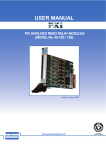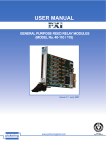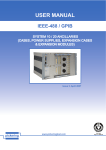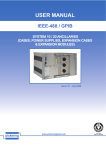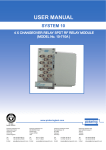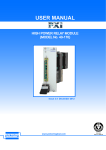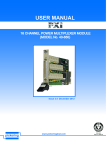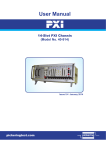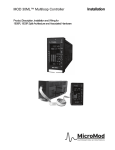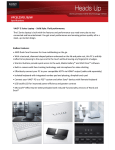Download pickering
Transcript
pickering USER MANUAL PXI MICROWAVE RELAY MODULE (MODEL No. 40-780-522/532/712) Issue 2, Sep 2005 pickering www.pickeringtest.com Microwave Relay MODULE 40-780-522/532/712 ISO 9002 Reg No. FM38792 Page pickering © Copyright (2005) Pickering Interfaces. All Rights Reserved. No part of this publication may be reproduced, transmitted, transcribed, translated or stored in any form, or by any means without the written permission of Pickering Interfaces. Technical details contained within this publication are subject to change without notice. Page ii Microwave Relay MODULE 40-780-522/532/712 pickering TECHNICAL SUPPORT For Technical Support please contact Pickering Interfaces either by phone, fax, the website or via e-mail. WARRANTY All products manufactured by Pickering Interfaces are warranted against defective materials and workmanship for a period of two years, excluding PXI chassis, from the date of delivery to the original purchaser. Any product found to be defective within this period will, at the discretion of Pickering Interfaces be repaired or replaced. Products serviced and repaired outside of the warranty period are warranted for ninety days. Extended warranty and service are available. Please contact Pickering Interfaces by phone, fax, the website or via e-mail. ENVIRONMENTAL POLICY Pickering Interfaces operates under an environmental management system similar to ISO 14001. Pickering Interfaces strives to fulfil all relevant environmental laws and regulations and reduce wastes and releases to the environment. Pickering Interfaces aims to design and operate products in a way that protects the environment and the health and safety of its employees, customers and the public. Pickering Interfaces endeavours to develop and manufacture products that can be produced, distributed, used and recycled, or disposed of, in a safe and environmentally friendly manner. Observe the Electrical Hazard Warning detailed in Section 9. Observe the Electrostatic Sensitive Device Caution detailed in Section 9. Worldwide Technical Support and Product Information http://www.pickeringtest.com Pickering Interfaces Headquarters Stephenson Road Clacton-on-Sea CO15 4NL United Kingdom Tel: +44 (0)1255-687900 Fax: +44 (0)1255-475058 E-Mail: [email protected] Pickering Interfaces Inc. 2900 Northwest Vine Street Grants Pass Oregon 97526 USA Pickering Interfaces GmbH Buchenstrasse 15 D-77880 Sasbach Germany Pickering Interfaces AB Karl Nordströmsväg 31 432 53 Varberg Sweden Tel: +1 541 471 0700 Fax: +1 541 471 8828 E-Mail: [email protected] Tel: +49 7841 66 49 10 Fax: +49 7841 66 49 12 E-Mail: [email protected] Tel: +46 340-69 06 69 Fax: +46 340-69 06 68 E-Mail: [email protected] Pickering Interfaces Inc. (East Coast Regional Office) 12 Alfred Street Suite 300-3 Woburn Massachusetts 01801 USA Pickering Interfaces GmbH (Office Munich) Feringastrasse 6 D-85774 München Germany Pickering Interfaces s.r.o. Smetanova 525 ˇ Trinec 739 61 Czech Republic Tel: +1 781 897 1710 Fax: +1 781 897 1701 E-mail: [email protected] Tel: +49 8999 216 160 Fax: +49 8999 216 200 E-mail: [email protected] Tel: +42 0558 339 168 Fax: +42 0558 339 168 E-mail: [email protected] Microwave Relay MODULE 40-780-522/532/712 Page iii pickering THIS PAGE INTENTIONALLY BLANK Page iv Microwave Relay MODULE 40-780-522/532/712 pickering CONTENTS Copyright Statement........................................................... ii Technical Support and Warranty........................................ iii Contents (this page)............................................................ v Section 1 Introduction.......................................................................... 1.1 Section 2 Technical Specification....................................................... 2.1 Section 3 Installation............................................................................ 3.1 Section 4 Programming....................................................................... 4.1 Section 5 Connector Pin Outs............................................................. 5.1 Section 6 Troubleshooting.................................................................. 6.1 Section 7 Functional Description........................................................ 7.1 Section 8 Parts List.............................................................................. 8.1 Section 9 Warnings and Cautions..................................................... 9.1 Microwave Relay MODULE 40-780-522/532/712 Page pickering THIS PAGE INTENTIONALLY BLANK Page vi Microwave Relay MODULE 40-780-522/532/712 Section 1 - introduction pickering SECTION 1 - INTRODUCTION GENERAL The 40-780-522/532/712 Microwave Relay Module forms part of the System 40 PXI Programmable Switching system. The Microwave Relay Module is provided in the following configurations: • • • 20GHz, 2 x Changeover (SPDT) Microwave Relays 50 Ω SMA Coaxial Connector (40-780-522) 25.6GHz, 2 x Changeover (SPDT) Microwave Relays 50 Ω SMA Coaxial Connector (40-780-532) 4GHz, 2 x Changeover (SPDT) Microwave Relays 75 Ω SMZ/Type 43 Coaxial Connector (40-780-712) Microwave Relay MODULE 40-780-522/532/712 Page 1. Section 1 - introduction pickering THIS PAGE INTENTIONALLY BLANK Page 1. Microwave Relay MODULE 40-780-522/532/712 Section 2 - SPECIFICATION pickering SECTION 2 - SPECIFICATION Specification (20GHz Version) Power Requirements Power consumption from the backplane supply is as follows: Characteristic Impedance: 50Ω Maximum Frequency: Rise Time: Insertion Loss (<20GHz): V.S.W.R. (<20GHz): Isolation (<20GHz): 20GHz <3ps <0.5dB <1:1.5 >60dB Maximum Power (<3GHz): Maximum Power (3 - 12GHz): Maximum Power (12 - 20GHz): 100W 60W 30W Maximum Voltage: Maximum Switch Current: 100Vd.c. 1A On Path Resistance: Off Path Resistance: <200mΩ >1010Ω Vibration: Sine 1mm, 5 - 60Hz Sine 10g 60 - 2000Hz Expected Life (Low Power): Expected Life (Max Power): 1x10 operations >5x106 operations PXI bus via 32 bit P1/J1 backplane connector. Signals via front panel mounted coaxial connectors. Switching Time: 15ms Product Order Codes +3.3V +5V +12V -12V 0 0.5A (typ 0.34A) 0 0 Width and Dimensions 40-780: Single slot 3U PXI (CompactPCI card). 40-782: Double slot 3U PXI (CompactPCI card). PXI & CompactPCI Compliance Additional Specification (26.5GHz & 40GHz Versions) Connectors 20GHz Microwave Relays, 50Ω SMA 1 x Changeover (SPDT) 2 x Changeover (SPDT) 40-780-512 40-780-522 40-780-532 40-780-532 Insertion Loss (<26.5GHz): V.S.W.R. (<26.5GHz): Isolation (<26.5GHz): <0.7dB <1:1.7 >55dB Expected Life: >1x107 operations 26.5GHz Microwave Relays, 50Ω SMA 1 x Changeover (SPDT) 2 x Changeover (SPDT) Insertion Loss (<40GHz): V.S.W.R. (<40GHz): Isolation (<40GHz): <0.8dB <1:1.9 >50dB 40GHz Microwave Relays, 50Ω SMA-2.9 1 x Changeover (SPDT) 2 x Changeover (SPDT) 40-780-542 40-780-542 Expected Life: 1x107 operations 50GHz Microwave Relays, 50Ω SMA-2.4 1 x Changeover (SPDT) 2 x Changeover (SPDT) 40-780-552 40-780-552 Additional Specification (50GHz & 65GHz Versions) Insertion Loss (<50GHz): V.S.W.R. (<50GHz): Isolation (<50GHz): <1.1dB <1:1.9 >50dB 65GHz Microwave Relays, 50Ω SMA-1.8 1 x Changeover (SPDT) 2 x Changeover (SPDT) 40-780-562 40-780-562 Expected Life: >1x107 operations Insertion Loss (<65GHz): V.S.W.R. (<65GHz): Isolation (<65GHz): <1.1dB <1:1.9 >50dB 2GHz Microwave Relays, 75Ω SMZ/Type 43 1 x Changeover (SPDT) 2 x Changeover (SPDT) 40-780-711 40-780-522 Expected Life: 1x107 operations 4GHz Microwave Relays, 75Ω mini-SMB 1 x Changeover (SPDT) 2 x Changeover (SPDT) 40-780-512 40-780-712 18GHz Microwave Transfer Switch, 50Ω SMA 1 x Transfer Switch 2 x Transfer Switch 40-782-521 40-782-522 Programming All PXI cards are supplied with complete Windows 98/2000/ NT/XP drivers, these perform the following functions:• • • • • Write word/s to card (to set relay pattern) Write bit to card (to operate an individual relay) Full relay status reporting Card identification and location information Set and read card calibration information Up to date driver software is available from our web site at www.pickeringtest.com Mating Connectors & Cabling Please refer to the Pickering Interfaces “Interconnection Solutions” catalog for a full list of connector/cabling options, including drawings, photos and specifications. This is available in either print or as a download. Alternatively our web site has dynamically linked connector/cabling options, including pricing, for all Pickering PXI modules. Latest Details Please refer to our Web Site for Latest Product Details. www.pickeringtest.com © Copyright (2005) Pickering Interfaces. All Rights Reserved Pickering Interfaces maintains a commitment to continuous product development, consequently we reserve the right to vary from the description given in this data sheet. 9 All Pickering Interfaces PXI cards comply with the PXI Specification 2.1. Local Bus, Interrupts, Trigger Bus and Star Trigger are not implemented. Supplied soft front panels and driver software are fully Windows 98/2000/NT/XP compatible. Pickering Interfaces are sponsor members of the PXI Systems Alliance www.pxisa.org www.pickeringtest.com E-Mail [email protected] Microwave Relay MODULE 40-780-522/532/712 Page 2. Section 2 - SPECIFICATION pickering THIS PAGE INTENTIONALLY BLANK Page 2. Microwave Relay MODULE 40-780-522/532/712 Section 3 - inSTALLATION pickering SECTION 3 - INSTALLATION Software Installation First install the appropriate Pickering PXI switch card drivers by running the installer program Setup.exe, either from the CD-ROM supplied, or by downloading the latest version from our website http://www.pickeringtest.com - the recommended method. There are different versions of the Setup program to suit different Windows versions and software environments. Setup is accompanied by a ReadMe file containing additional installation information. A single installation covers all cards in the System 40, System 45 and System 50 ranges. When installation completes, the installed drivers’ ReadMe file is offered for display. It can also be displayed later using a shortcut on the Programs>>Pickering menu. If you are not a LabVIEW user you should choose the “full” version, and once that has been installed run the LabVIEW Runtime Engine installer via the shortcut on the Programs>>Pickering menu. In the absence of LabVIEW the Runtime Engine is required to support the Pickering Test Panels application. Hardware Installation CAUTION Electrostatic discharge can damage the components on the module. To avoid such damage in handling the board, touch the anti-static bag to a metal part of the chassis before removing the board from the bag. Ensure that there is adequate ventilation in accordance with the PXI Specification. The module should be installed in accordance with the following procedure: 1. Ensure that the system is turned OFF but still connected to mains so that it remains grounded. 2. Choose an appropriate slot in the rack. 3. Remove the blanking plate for the chosen slot. 4. Ensure that the injector/ejector handle is in its downward position. Align the module with the card guides on the top and bottom of the slot. CAUTION Do not raise the injector/ejector handle whilst inserting the module. The module will not insert properly unless the handle is in its downward position. 5. Hold the handle whilst slowly sliding the module into the card guides until the handle catches on the injector/ ejector rail (refer to Figure 3.1). 6. Raise the injector/ejector handle until the module firmly seats into the backplane. The front panel of the module should be flush with the front panel of the chassis. 7. Screw the front panel of the module to the front panel mounting rail. 8. In a system employing MXI-3 to connect a desktop PC to a PXI chassis or to link multiple chassis, power-up the system as follows: a. For a system comprising a PC and one chassis, power up the chassis before powering up the PC. b. For a system comprising more than one chassis, turn ON the last chassis in the system followed by the penultimate, etc, and finally turn ON the PC or chassis containing the system controller. Microwave Relay MODULE 40-780-522/532/712 Page 3. Section 3 - inSTALLATION pickering Figure 3.1 - Installing the module into a PXI/Compact PCI Chassis Testing Operation Start the Test Panels application from the Programs>>Pickering>>PXI Utilities menu. If you are a LabVIEW user, run “Test Panels (LabVIEW VI)”; if not, run “Test Panels (EXE)”. A selector panel will appear, listing all installed Pickering PXI switch cards. Click on the card you wish to control, and a graphical control panel is presented allowing operation of the card. Panels can be opened simultaneously for all the installed cards. Figure 3.2 - Typical Test Panel Display Page 3. Microwave Relay MODULE 40-780-522/532/712 pickering Section 3 - inSTALLATION As an alternative to the Test Panels, the simple Terminal Monitor program PILMon (again on the Programs>>Pickering>>PXI Utilities menu) allows access to all functions of Pickering switch cards through a command-line interface. In PILMon, enter “HE” for help on it’s commands. Please note that both the Test Panels and Terminal Monitor gain exclusive access to the cards, and so only one of them can be operational at any time. Microwave Relay MODULE 40-780-522/532/712 Page 3. Section 3 - inSTALLATION pickering THIS PAGE INTENTIONALLY BLANK Page 3. Microwave Relay MODULE 40-780-522/532/712 Section 4 - PROGRAMMING pickering SECTION 4 - PROGRAMMING System 40, System 45 and System 50 cards are supported by comprehensive Windows software drivers and can also be programmed at register-level. There are two separate Windows drivers, one accessing cards by Direct I/O and the other through VISA (Virtual Instrument Software Architecture). Both are fully documented by ReadMe and HTML help files, accessible through shortcuts on the Programs>>Pickering menu. The following programming environments are supported for both drivers: • • • • • Microsoft Visual Basic Microsoft Visual C++ Borland C++ National Instruments LabWindows/CVI National Instruments LabVIEW Support for all these environments is included in the standard installation. Please refer to the PXI Switching Programming Manual for complete programming information. This manual is available on the Pickering Interfaces website at http://www.pickeringtest.com. Microwave Relay MODULE 40-780-522/532/712 Page 4. Section 4 - PROGRAMMING pickering THIS PAGE INTENTIONALLY BLANK Page 4. Microwave Relay MODULE 40-780-522/532/712 Section 5 - PIN OUTS pickering SECTION 5 - CONNECTOR PIN OUTS Figure 5.1 provides pin outs for the Microwave Relay Modules in the 40-780-522/532/712 model range. pickering N/C COM N/O N/C COM N/C Figure 5.1 - Microwave Relay Module 40-780-522/532/712: Pin Outs Microwave Relay MODULE 40-780-522/532/712 Page 5. Section 5 - PIN OUTS pickering THIS PAGE INTENTIONALLY BLANK Page 5. Microwave Relay MODULE 40-780-522/532/712 Section 6 - TROUBLESHOOTING pickering SECTION 6 - TROUBLESHOOTING Installation Problems The Plug & Play functionality of Pickering switch cards generally ensures trouble-free installation. If you do experience any installation problems you should first ensure that all cards are properly seated in their slots. Improperly mated cards may go undetected by the operating system, or may be detected as a card of an unknown type. They can also cause the computer to freeze at various stages in the boot sequence. If your system employs MXI-3 you should check the integrity of all MXI-3 links. When the system is powered up, and during Windows start-up, you should expect to see periodic activity on the MXI-3 RX/TX (yellow) indicators, clearing to leave only the PWR/LNK (green) LEDs illuminated. The RX/TX indicators should show activity when you attempt to access a card. Diagnostic Utility The Pickering Diagnostic Utility (accessible through the Programs>>Pickering>>PXI Utilities menu) generates a diagnostic report of the system’s PCI configuration, highlighting any potential configuration problems. Specific details of all installed Pickering switch cards are included. All the installed Pickering switch cards should be listed in the “Pilpxi information” section - if one or more cards is missing it may be possible to determine the reason by referring to the PCI configuration dump contained in the report, but interpretation of this information is far from straightforward, and the best course is to contact Pickering support: [email protected], if possible including a copy of the diagnostic report. In the “VISA information” section, if VISA is not installed it’s absence will be reported. This does not affect operation using the Direct I/O driver, and is not a problem unless you wish to use VISA. VISA is a component of National Instruments LabWindows/CVI and LabVIEW, or is available as a standalone environment. If VISA is present and is of a sufficiently recent version, the section “Pipx40 information” should present a listing similar to “Pilpxi information”. Please note that the Diagnostic Utility cannot access cards if they are currently opened by some other application, such as the Test Panels or Terminal Monitor. Microwave Relay MODULE 40-780-522/532/712 Page 6. Section 6 - TROUBLESHOOTING THIS PAGE INTENTIONALLY BLANK Page 6. Microwave Relay MODULE 40-780-522/532/712 pickering Section 7 - FUNCTIONAL DESCRIPTION pickering SECTION 7 - FUNCTIONAL DESCRIPTION Mechanical Description The Microwave Relay Module conforms to the 3U height (128mm) Eurocard standard. The module comprises the following: • • • • • • CPCI Ejector Handle Front Panel mounted 50Ω SMA connectors or 75Ω SMZ/Type 43 connectors Two Microwave Relays Compact PCI backplane connector PCI Bridge (U1) Control Logic The front panel is secured to the PCB by two M2.5 x 6mm pan-head posi-drive screws. Microwave Relay MODULE 40-780-522/532/712 Page 7. Section 7 - FUNCTIONAL DESCRIPTION pickering Functional Description A functional block diagram is provided in Figure 7.1. The Microwave Relay Module is powered by +12V and +5V inputs via Compact PCI connector J1. The interface to the user test equipment is via the front panel mounted SMA or SMZ/Type 43 connectors. The module comprises a PCB populated with control logic and front panel mounted changeover Microwave Relays. The relays are energised via control signals from relay driver U10. The relay driver is addressed by PCI bridge U1, via output register U8, to output the required signal. PCI Bridge U1 is configured by EEPROM U2. RELAY COILS RELAY CONTACTS a C b a C b RELAY DRIVER U10 COMPACT PCI BUS CONNECTOR J1 OUTPUT REGISTER U8 PCI BRIDGE U1 TERMINATING RESISTORS R4 TO R15 MODULE CONFIGURATION U5, U6 AND U7 +12V +5V PCI BRIDGE CONFIGURATION U2 Figure 7.1 - Microwave Relay Module: Functional Block Diagram Page 7. Microwave Relay MODULE 40-780-522/532/712 0V Section 8 - PARTS LIST pickering SECTION 8 - PARTS LIST The following pages provide a parts list and a component layout diagram for the Microwave Relay Module. Microwave Relay MODULE 40-780-522/532/712 Page 8. Section 8 - PARTS LIST pickering Table 8.1 provides a parts list and Figure 8.1 a component layout diagram for the 40-780-522/532/712 Multiplexer Module. TABLE 8.1 - Microwave Relay Module 40-780-522/532/712 Parts List PCB Location Pickering Interfaces Part Number Part Description Quantity R1, R2 C/RS/079 RESISTOR N/W 4 x 10k 1206 2 R3 C/RS/085 RESISTOR 10k 0805 1 R4 to R15 C/RS/102 RESISTOR N/W 4 x 10R 1206 Relays C/RL/022 12 2 C/CN/305 TWO WAY CONNECTOR, MOLEX C1, C2, C5 to C23 C/CP/034 CAPACITOR 100nF 0603 21 C3, C4, C24, C25 C/CP/024 CAPACITOR 10uF TANT SMD 4 J1 C/CN/355 cPCI J1 CONNECTOR 1 U1 C/IC/098 PCI9050 PQFP 1 U2 C/IC/099 93CS46 DIP 1 C/IC/035 8 PIN DIP SKT 1 U3 C/IC/056 7705 SOP 1 U4 C/IC/087 74HCT32 SOP 1 U5, U8, U9 C/IC/100 74HCT273 SOP 3 U6 C/IC/101 74HCT244 SOP 1 U7 C/IC/090 93C56 SOP 1 U10 C/IC/038 UDN2981A 1 Page 8. Microwave Relay MODULE 40-780-522/532/712 1 GND U10 C19 HD8 HD7 HD5 HD4 HD3 HD2 HD1 C23 HD6 Section 8 - PARTS LIST pickering U2 C6 U4 C17 C11 R2 + U9 R1 C25 C22 C4 U8 R4 C12 R3 C10 MOLEX 2-WAY RECEPTICAL U5 + R5 R6 R7 R8 R9 R10 R11 R12 R13 C7 R14 C8 1 R15 C21 + 201r0 07/99 C3 C24 + U1 C9 pickering C12 U7 C15 U6 C2 U3 C14 C1 LD8 LD7 LD6 C13 GND C18 LD5 LD4 LD3 LD2 LD1 C16 +5V C5 J1 Figure 8.1 - Microwave Relay Module: Component Layout Microwave Relay MODULE 40-780-522/532/712 Page 8. Section 8 - PARTS LIST pickering THIS PAGE INTENTIONALLY BLANK Page 8. Microwave Relay MODULE 40-780-522/532/712 pickering SECTION 9 - WARNINGS AND CAUTIONS WARNING - DANGER OF ELECTRIC SHOCK THIS MODULE MAY CONTAIN HAZARDOUS VOLTAGES. BEFORE REMOVING THE MODULE FROM THE RACK REMOVE ALL SUPPLIES. CAUTION Handling of Electrostatic-Sensitive Semiconductor Devices Certain semiconductor devices used in the equipment are liable to damage due to static voltage. Observe the following precautions when handling these devices in their unterminated state, or sub-units containing these devices: (1) Persons removing sub-units from an equipment using these devices must be earthed by a wrist strap and a resistor at the point provided on the equipment. (2) Soldering irons used during the repair operations must be low voltage types with earthed tips and isolated from the mains voltage by a double insulated transformer. (3) Outer clothing worn must be unable to generate static charges. (4) Printed Circuit Boards (PCBs) fitted with these devices must be stored and transported in anti-static bags. Microwave Relay MODULE 40-780-522/532/712 Page 9. pickering THIS PAGE INTENTIONALLY BLANK Page 9. Microwave Relay MODULE 40-780-522/532/712




























